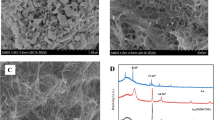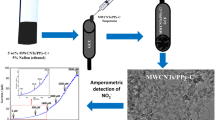Abstract
A novel and convenient electrochemical sensor, based on multi-walled carbon nanotube (MWCNT)–poly-melamine(PMel)–silver nanoparticle (AgNP) composite-modified glassy carbon electrode (GCE), was fabricated for the determination of nitrobenzene (NB). The modified electrode not only played an efficient electrocatalytic role for the reduction of NB but also significantly reduced the overpotential of NB, and the peak current increased greatly compared with bare GCE or other modified electrodes. The excellent performance of NB sensor can be ascribed to the synergistic effect between MWCNT and AgNP. The synergistic effect promoted the electron transfer between MWCNT and AgNP significantly and enhanced the electrochemical reduction ability of NB remarkably. Besides, PMel has huge nitrogen and amine groups, which contributes to the dispersion of silver nanoparticles and also improves the electrocatalytic activity and sensitivity of the sensor. The integration of PMel/MWCNT with AgNP provided a high-performance platform for the NB determination. Under the optimized experimental conditions, the developed sensor showed a wide linear calibration ranges from 20 to 1000 μM and from 1000 to 6000 μM, with a low detection limit (0.55 μM) for the detection of NB. At the same time, the modified electrode exhibited good stability and reproducibility and acceptable selectivity. Moreover, the proposed sensors were successfully employed to determine NB in real samples, and the recoveries were between 97.2 and 104.6 %.








Similar content being viewed by others
References
Bhatkhande DS, Pangarkar VG, Beenackers A (2003) Photocatalytic degradation of nitrobenzene using titanium dioxide and concentrated solar radiation: chemical effects and scaleup. Water Res 37:1223–1230
Kuscu OS, Sponza DT (2009) Effects of nitrobenzene concentration and hydraulic retention time on the treatment of nitrobenzene in sequential anaerobic baffled reactor (ABR)/continuously stirred tank reactor (CSTR) system. Bioresource Technol 100:2162–2170
Morgan KT, Gross EA, Lyght O et al (1985) Morphologic and biochemical studies of a nitrobenzene-induced encephalopathy in rats. Neurotoxicology 6:105–116
Qin QD, Ma J, Liu K (2007) Adsorption of nitrobenzene from aqueous solution by MCM-41. J Colloid Interf Sci 315:80–86
Meenal K, Ambalal C (2007) Microbial remediation of nitro-aromatic compounds: an overview. J Environ Manage 85:496–512
Agrawal A, Tratnyek PG (1995) Reduction of nitro aromatic compounds by zero-valent iron metal. Environ Sci Technol 30:153–160
Li HL, Cheng Y, Wang HF et al (2003) Inhibition of nitrobenzene-induced DNA and hemoglobin adductions by dietary constituents. Appl Radiat Isot 58:1131–1142
Robbiano L, Baroni D, Carrozzino R et al (2004) DNA damage and micronuclei induced in rat and human kidney cells by six chemicals carcinogenic to the rat kidney. Toxicology 204:187–195
Wang SP, Chen HJ (2002) Separation and determination of nitrobenzenes by micellar electrokinetic chromatography and high-performance liquid chromatography. J Chromatogr A 979:439–446
Li X, Chen JM, Du LC (2007) Analysis of chloro- and nitrobenzenes in water by a simple polyaniline-based solid-phase microextraction coupled with gas chromatography. J Chromatogr A 1140:21–28
Zhang GJ, Zhou X, Zang XH et al (2014) Analysis of nitrobenzene compounds in water and soil samples by graphene composite-based solid-phase microextraction coupled with gas chromatography–mass spectrometry. Chinese Chem Lett 25:1449–1454
Peng XT, Zhao X, Feng YQ (2011) Preparation of phenothiazine bonded silica gel as sorbents of solid phase extraction and their application for determination of nitrobenzene compounds in environmental water by gas chromatography–mass spectrometry. J Chromatogr A 1218:9314–9320
Cui S, Liu XY, Liu Y et al (2010) Adsorption properties of nitrobenzene in wastewater with silica aerogels. Sci China Technol Sci 53:2367–2371
Balamurugan T, Selvakumar P, Chen SM (2015) An amperometric nitrobenzene electrochemical sensor based on electrochemically activated graphite modified screen printed carbon electrode. Int J Electrochem Sci 10:4173–4182
Pankaj KR, Vellaichamy G, Krishnamoorthi S (2014) Palladium nanoparticles incorporated polymer-silica nanocomposite based electrochemical sensing platform for nitrobenzene detection. Electrochim Acta 147:442–450
Santos TRM, Munoz R et al (2014) Electrochemical determination of organic compounds in automotive fuels. Electroanal 26:233–242
Li F, Song JX, Gao DM et al (2009) Simple and rapid voltammetric determination of morphine at electrochemically pretreated glassy carbon electrodes. Talanta 79:845–850
Qian H, Ye J, Jin L (1997) Study of the electrochemical properties of C60 modified carbon paste electrode and its application for nitrobenzene quantitation based on electrocatalytic reduction. Anal Lett 30:367–381
Qi B, Lin F, Bai J et al (2008) An ordered mesoporous carbon/didodecyldimethylammonium bromide composite and its application in the electro-catalytic reduction of nitrobenzene. Mater Lett 62:3670–3672
Arula NS, Mangalaraj D, Nandha KP et al (2015) Synthesis and characterization of α-Fe2O3 micro-/nanorods-modified glassy carbon electrode for electrochemical sensing of nitrobenzene. Ceram Int 41:5568–5573
Luo LQ, Wang X, Ding YP et al (2010) Electrochemical determination of nitrobenzene using bismuth-film modified carbon paste electrode in the presence of cetyltrimethylammonium bromide. Anal Methods 2:1095–1100
Devi P, Reddy P, Arora S et al (2012) Sensing behavior study of silica-coated Ag nanoparticles deposited on glassy carbon toward nitrobenzene. J Nanopart Res 14:1–8
Song YH, Cui K, Wang L et al (2009) The electrodeposition of Ag nanoparticles on a type I collagen-modified glassy carbon electrode and their applications as a hydrogen peroxide sensor. Nanotechnol 20:4227–4228
Palanisamy S, Karuppiah C, Chen SM (2014) Direct electrochemistry and electrocatalysis of glucose oxidase immobilized on reduced graphene oxide and silver nanoparticles nanocomposite modified electrode. Colloid Surface B 114:164–169
Bailure SS, Wlodzimierz K, Francis DS (2003) Electrocatalytic properties and sensor applications of fullerenes and carbon nanotubes. Electroanalytical 15:753–772
Kay HA, Kwan KJ, Jeong KH et al (2002) High-capacitance supercapacitor using a nanocomposite electrode of single-walled carbon nanotube and polypyrrole. J Electrochem Soc 149:A1058–A1062
Hang Y, Zhuang HS (2009) Poly (acridine orange) film modified electrode for the determination 1-naphthol in the presence of 2-naphthol. Electrochim Acta 54:7364–7369
Wu TM, Chang HL, Lin YW (2009) Synthesis and characterization of conductive polypyrrole/multi-walled carbon nanotubes composites with improved solubility and conductivity. Compos Sci Technol 69:639–644
Wang L, Zhu HZ, Song YH et al (2012) Architecture of poly(o-phenylenediamine)–Ag nanoparticle composites for a hydrogen peroxide sensor. Electrochim Acta 60:314–320
Selvaraj V, Alagar M (2007) Pt and Pt-Ru nanoparticles decorated polypyrrole/multiwalled carbon nanotubes and their catalytic activity towards methanol oxidation. Electrochem Commun 9:1145–1153
Zhang J, Anson FC (1993) Electrocatalysts for the reduction of O2 and H2O2 based on complexes of Cu(II) with the strongly adsorbing 2,9-dimethyl-1,10-phenanthroline ligand. Electrochim Acta 38:2423–2429
Xi L, Ren D, Luo J, Zhu Y (2010) Electrochemical analysis of ascorbic acid using copper nanoparticles/polyaniline modified glassy carbon electrode. J Electroanal Chem 650:127–134
Sainsbury T, Ikuno T, Zettl AK (2014) Functionalized boron nitride nanotubes. Solid State Commu 142:643–646
Baskar S, Chang JL, Zen JM (2013) Extremely stable copper–polymelamine composite material for amperometric hydrogen peroxide sensing. J Polym Sci Pol Phys 51:1639–1646
Baskar S, Liao CW, Chang JL et al (2013) Electrochemical synthesis of electroactive poly(melamine) with mechanistic explanation and its applicability to functionalize carbon surface to prepare nanotube–nanoparticles hybrid. Electrochim Acta 88:1–5
He SJ, Chen ZG, Yu YY et al (2014) A novel non-enzymatic hydrogen peroxide sensor based on poly-melamine film modified with platinum nanoparticles. RSC Adv 4:45185–45190
Wang K, Li M, Liu YN et al (2014) Effect of acidification conditions on the properties of carbon nanotube fibers. Appl Surf Sci 292:469–474
Thirumalraj B, Palanisamy S, Chen SM (2015) An amperometric nitrobenzene electrochemical sensor based on electrochemically activated graphite modified screen printed carbon electrode. Int J Electrochem Sci 10:4173
Rastogi PK, Ganesan V, Krishnamoorthi S (2014) Palladium nanoparticles incorporated polymer-silica nanocomposite based electrochemical sensing platform for nitrobenzene detection. Electrochim Acta 147:442–450
Liang F, Liu B, Deng Y et al (2011) Preparation and characterization of attapulgite-silver nanocomposites and their application to the electrochemi-cal determination of nitrobenzene. Microchim Acta 174:407–412
Singh S, Devi P, Singh D et al (2012) Sensing behavior of silica-coated Au nanoparticles towards nitrobenzene. Gold Bull 45:75–81
Liu C, Cao H, Li Y et al (2006) Gold nanoparticles/multi-wall carbon nanotubes modified pyrolytic graphite electrode as an electrochemical sensor for nitrobenzene determination. J New Mater Electrochem Syst 9:139–144
Manivannan S, Ramaraj R (2012) Synthesis of cyclodextrin-silicate sol–gel composite embedded gold nanoparticles and its electrocatalytic application. J Chem Eng J 210:195–202
Fakhari AR, Ahmar H (2011) A new method based on headspace adsorptive accumulation using a carboxylated multi-walled carbon nanotubes modified electrode: application for trace determination of nitrobenzene and nitro-toluene in water and wastewater. Anal Methods 3:2593–2598
Xu G, Li B, Wang X et al (2014) Electrochemical sensor for nitrobenzene based on carbon paste electrode modified with a poly(3,4-ethylenedioxythiophene) and carbon nanotube nanocomposite. Microchim Acta 181:463–469
Acknowledgments
This work was financially supported by the Natural Science Foundation of Hebei Province of China (No. B2016206150).
Author information
Authors and Affiliations
Corresponding author
Ethics declarations
Conflict of interest
The authors declare that they have no conflict of interest.
Rights and permissions
About this article
Cite this article
Ren, J., Li, L., Cui, M. et al. Nitrobenzene electrochemical sensor based on silver nanoparticle supported on poly-melamine functional multi-walled carbon nanotube. Ionics 22, 1937–1945 (2016). https://doi.org/10.1007/s11581-016-1713-2
Received:
Revised:
Accepted:
Published:
Issue Date:
DOI: https://doi.org/10.1007/s11581-016-1713-2




